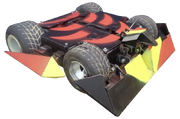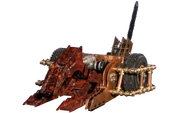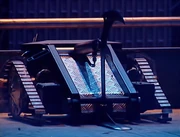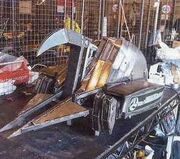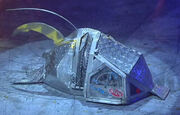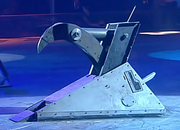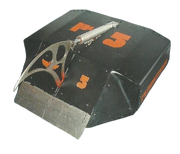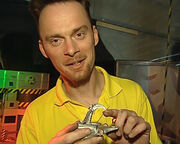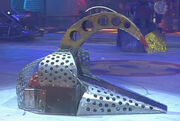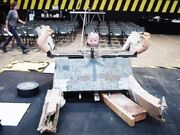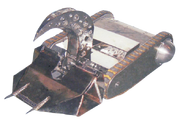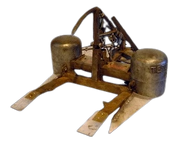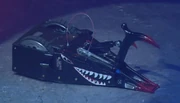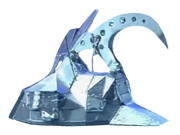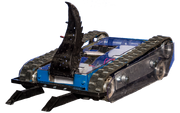Vertical crushers are one of the most prominent forms of gripping weapons found in Robot Wars.
The pioneer of this type of weapon, and by far the most successful, was double World Champion and UK Series 5 champion Razer. The weapon is so closely identified with its pioneer that most vertical crushers are instantly compared with Razer; Jonathan Pearce made the comparison frequently during his commentaries.
Despite Razer's enormous success with its weapon, few others replicated the level of success, and none reached the semi-finals. Other robots to enjoy some success with vertical crushers include Extreme 2 University Challenge champion Tiberius 3 and Nickelodeon Robot Wars International Tag Team champion Ming 3.
Definition[]
A vertical crusher, as the name suggests, is designed to attack the top of a robot, usually with a spike or crushing claw. To maximise attacking potential, they are almost always hydraulically powered, often allowing the crushing arm to deliver several tonnes of pressure.
Advantages and Disadvantages[]
Advantages
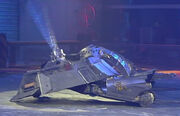
Razer cuts into Terrorhurtz
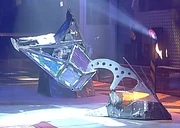
Tiberius 3 lifts Roobarb into the air
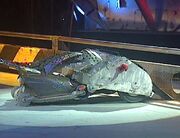
Razer punctures Chaos 2's gas canister during the First World Championship
- Vertical crushers are very effective at trapping and piercing through opponents, and are even capable of lifting robots off the ground without the need for additional lifting weapons. Both Razer and Tiberius 3 demonstrated these qualities on several occasions.
- They can often immobilise a competing robot in a single attack, by piercing through armour and damaging vital components such as motors, wheels or batteries. Many of Razer's victories involved it biting down on such components, such as the wheels of Tornado and Milly-Ann Bug, and the CO2 canister of Chaos 2.
- They could offer a very effective weapons synergy when combined with a wedge or a lifting weapon. Razer enjoyed considerable success in using its wedge to get underneath opponents before grabbing them, while other robots such as Mantis and the Series 5-6 versions of Tetanus combined crushers with lifters, giving them the potential to lift and crush simultaneously as well as possibly dump competitors out of the arena.
- When a robot has gripped another robot, it can control opponents by pushing it around the arena with precise control.
- Although grabbing attacks are limited to a maximum of 30 seconds, this can be circumvented by releasing the weapon and swerving in place, a tactic often used by Razer. Robots with crushers are also forgiven when the release of an opponent proves to be impossible, such as Tiberius 3's extended grabs on Roobarb and M2.
Disadvantages
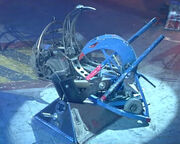
R.O.C.S. exhibits its vulnerability as Pinser and Mantis try to attack its exposed internals
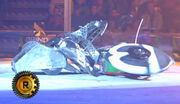
Razer has one of its self-righting wings ripped off by 13 Black
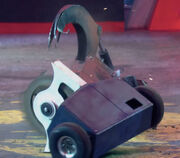
Soldier Ant's crusher is ripped apart by Kadeena Machina
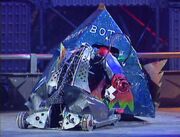
Razer was initially unable to damage Aggrobot's steep sides
- The weapons systems of hydraulic crushers take up a significant amount of the robot's weight, resulting in it having to feature minimal armour or have numerous holes drilled into the robot in order to keep it within the weight limit. The distinctive designs of most crushers, such as those of Razer, Tiberius 3 and Snake Bite, were a direct result of this limitation.
- As a result, many robots with hydraulic crushers had very little or no armour at all. With its electronics completely exposed, R.O.C.S. was especially vulnerable to attacks from fellow crusher Pinser, while Razer was protected by a very thin layer of armour prior to the weight limit increase, which was easily damaged by Pussycat in Series 4.
- Vertical crushers often have slow, inefficient, or non-existent self-righting mechanisms. Mechanisms usually include arms or 'wings' connected to the crusher (e.g. Razer, Ming 3), and can be easily damaged, as Razer's encounters with Big Nipper and 13 Black demonstrate.
- Additionally, these mechanisms could be rendered ineffective if a robot was flipped into a certain position. Razer's wings were not designed to right it when it was flipped onto its back, for example.
- These crushers are also difficult to incorporate into an invertible design without leaving a high ground clearance. The Series 5 version of Suicidal Tendencies is a notable exception.
- As crushers are normally powered by hydraulics, the weapon is necessarily slow, so requires a skilful driver or secondary weapon in order to trap the opponent in place long enough to pierce it. While being generally successful in trapping and piercing its opponents, Razer was notably unable to attack the fast-moving Onslaught in the fourth round of the Southern Annihilator.
- Crushers are often vulnerable to being damaged, especially from rotating or overhead weapons such as flywheels and axes. Ming 3's losses to Terrorhurtz and Supernova especially demonstrate this fragility, as does Soldier Ant's defeat in Battle of the Stars, where its crusher was ripped apart following an attack by Kadeena Machina.
- A crusher may not be able to reach tall opponents. Because of this, Razer was unable to pierce Attila the Drum at all during the Southern Annihilator, and initially had difficulty crushing through Aggrobot in Series 3.
- A competitor featuring smooth, slanted sides may be extremely resistant to vertical crushers. Razer was unable to pierce Backstabber, and struggled to damage Aggrobot and Cyrax during its battles against them.
List of Robots with Vertical Crushers[]
Robots are listed alphabetically.
DESKTOP MODE ONLY: Robots which are not heavyweight entries are listed with a green background.
| Robot | Series Appearances with Vertical Crushers | Notes | Image |
|---|---|---|---|
| Androne 4000 | Series 10 | Consists of a vertical piercing spike on a pivoted arm, driven by hydraulic and electric systems and capable of doubling as a self-righting mechanism. Crusher has a force of 8 tonnes using a 4,000psi ram. | |
| Cobra | Series 9-10 | Small gripping weapon in the design of a cobra's head. | |
| Coyote | Series 9-10 | Worked in conjunction with two lifters to grip and lift robots. The weaponry weighed roughly 50kg in total, half the weight of the full robot. Used in conjunction with a chainsaw. | |
| Cronos | Series 4 | The crusher was combined with a flipper in one mechanism. | |
| Crusher | Series 3 | Caused notable damage to Beast of Bodmin in Round 1. | |
| Eruption | Series 8-10 | Intended to hold robots on Eruption's flipper. Interchangeable with another top-mounted weapon. Not used in battle during Series 10. | |
| Lower | Extreme 2 | Antweight Championship finalist in Extreme 2. | |
| Mantis | Series 7 | Combined a large vertical gripping claw with a lifter, giving it the capability to lift and hold robots aloft. | |
| Metalis | Series 7 | Coupled with a lifter and a self-righting mechanism that failed to work. | |
| Ming 3 | UK Series 5-6, Extreme 1, Nickelodeon | Equipped with a vertical crusher and two side arms that extended when the crusher lowered. Nickelodeon Tag Team Terror champion with Rick. | |
| NAMAZU | Dutch Series 2 | Walkerbot | |
| Philipper 2 | Dutch Series 2, Extreme 2, German Series | Runner-up of Dutch Series 2. Crusher replaced the rear lifter/flipper of the original Philipper. | |
| Pinser | Series 7 | One of the two strongest vertical crusher weapons in the Seventh Wars. | |
| Plunderbird | UK Series 4-5, Extreme 1, US Season 1 | Described as a "slicer-dicer", in Series 4 (Plunderbird 4), and a "Plunderthocker" in Extreme 1 and Series 5 (Plunderbird 5). | |
| Razer | UK Series 2-6, 8, Extreme 1-2, US Season 1-2 | First competitor to feature a crushing 'beak', and the most successful. Double World Champion, Series 5 Champion and Series 6 runner-up. Two cable-powered self-righting 'wings' added in Series 3, each one on either side of the 'beak'. | |
| Razzler | Extreme 1 | The first non-heavyweight robot to have a crusher. Made from a Razer pullback toy. | |
| R.O.C.S. | Series 6-7 | Originally competed in Series 2 and side events of Series 3 without a crusher, before using the weapon in later series. | |
| Serpant | Extreme 2 | Worked in conjunction with a lifter. | |
| Snake Bite | German Series, Extreme 2, UK Series 7 | Competed in the European Championship and the Third World Championship, representing Switzerland. | |
| Soldier Ant | Series 9 | Competed exclusively in Battle of the Stars. | |
| Spike | MTV Pilot | Did not compete on televised Robot Wars, appearing only in the unaired American Robot Wars 2000 pilot. | |
| Suicidal Tendencies | Series 5, Extreme 1 | Used a small crusher powered by a motor and custom reduction gearbox,[1][2] working in tandem with a front lifting scoop. Previously competed in Series 3-4 without a crushing weapon. | |
| Tetanus | Series 5-6 | Twin (Series 5) or single (Series 6) crushers combined with lifting forks intended to lift and crush simultaneously. Removed from Tetanus 2 for Extreme 2. | |
| The Executioner | Series 5, Extreme 1 | Redesigned without the crusher for Series 7. | |
| The Kraken | Series 7 | Featured dual gripping weapons, a pneumatic crusher for grabbing and a hydraulic crusher for piercing opponents. | |
| Tiberius | Series 4-7, Extreme 2 | Originally a grabbing spike in Series 4, replaced with a claw-like weapon for Series 5 onwards. Series 7 Heat Finalist and Extreme 2 University Challenge champion. | |
| Track-tion | Series 10 | Front crushing/gripping arm is capable of exerting a force of 600kg. | |
| TX-108 | Extreme 1 | Not seen on television, its only battle went unaired and the robot failed to qualify for any series. One of two robots with a crusher where the claw was pulled down instead of being pushed down, the other being the Series 4 version of Tiberius. Intended to self-right on its own. |
Trivia[]

PacifieR before Series 9
- Dutch robot PacifieR (successor to PulverizeR) was also slated to compete in Series 9, but withdrew from its battle at the last moment due to a circuitry issue, and it did not compete on Robot Wars. PacifieR did, however, provide the basis for Team P.C.P.'s successful BattleBots competitor Petunia.
- Wraith also withdrew from the pilot episode filmed before Series 8, where it would have used harpoons to crush against the surface of the arena floor.
References[]
[]
| ||||||||||||||||||||||||||||||||


